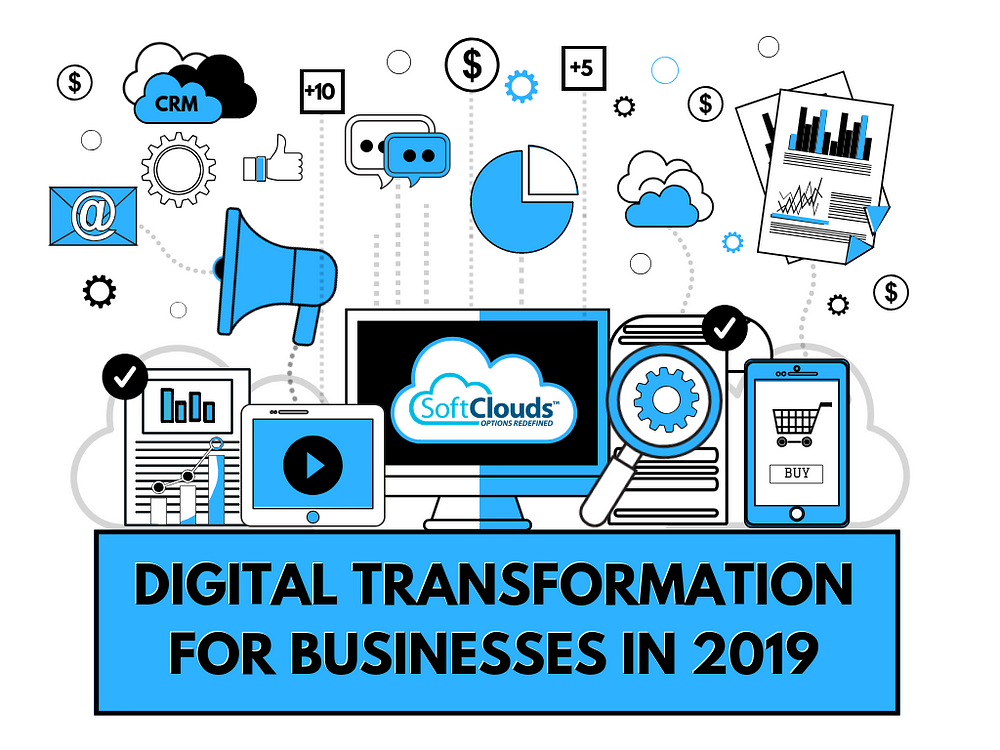Digital Transformation for businesses in 2019

Digital Transformation for businesses in 2019
Digital transformation explained for every main role in an organization
Digital transformation explained for every main role in an organization
Digital transformation will be at the top of business priorities for 2019
It’s almost impossible to scale a business these days without transforming digitally. Companies take the first steps into digital transformation when they purchase a marketing tool like Hubspot, Eloqua or Marketo, or a service/sales solution like Oracle Service Cloud or Oracle Engagement Cloud. However, for most companies, it stops there because there is no cohesive strategy, roadmap, or an end goal.
According to IDG, 89% of enterprises plan to adopt or have already adopted a digital-first business strategy. Following the example of the Financial Services (93%) and Healthcare (92%) industry, high-tech, retail, education, manufacturing, and government are promptly adopting digital-first strategies to improve process efficiencies and meet and exceed customer expectations.
Digital Transformation — where to start in 2019
The first and most crucial step towards digital transformation in 2019 will be for the IT, Sales, Service, and Marketing department heads to get together with the CEO and create a cohesive digital transformation strategy with a firm plan on getting all the employees on board. A full business digital transformation can only be successful if the CEO and all the department heads join efforts and oversee the whole process from beginning to end. The next step for a business to transform digitally will be to hire an experienced technology partner to help them select the right tools that fit their digital transformation strategy and implement them.

The CEO’s role in digital transformation

The primary role that the CEO will play in digital transformation process will be in reinventing the current company culture and move it towards one that is digitally ready — leading the way behind the effort so the whole organization can move forward. Moreover, this new company culture needs to be easy for the employees to understand and accept so they can fully adapt. Top-level leadership can decide priorities and which way to move an organization, especially when it comes to significant shifts like this one. In 2019, how involved a CEO is with a company’s digital transformation will determine its success.
• 70% of companies consider their CEOs to have an adequate or above average practical understanding of new technologies
• 41% of CEOs are leading more digitally mature organizations versus CIOs who make up just 16%
• CEOs or Board members are driving 50% of a company’s digital transformation efforts.
Sales executive’s role in digital transformation

The role of a sales executive is to give importance to selling systems and replacing traditional selling tools with digital tools, such as replacing cold calls with social media interaction. Sales executives need to understand that customers are changing, wanting personalized offerings, engaging experiences, and information instantly — whether on their mobile devices or laptops. Using digital technologies will help meet customer expectations by keeping sales one step ahead of them. Sales executives will need to help sales reps to identify the right customers using the right digital tools, such as tools for optimizing pricing and tools that identify customer trends and patterns.
· About 78% of sales professionals who use social media get better results than those who don’t
· 90% of decision makers never answer unsolicited calls
The role of IT in digital transformation

Digital Transformation is a major business change, and because it requires a complicated implementation of new technologies to replace the old ones, by default, the IT department is expected to lead the way. In 2019 the majority of business will need to start switching from traditional IT methods and operations to more agile methods. In collaboration with a technology partner IT can help develop new business models to aid with all the digital changes that are occurring and will continue to do so. Digital transformation will be a success if the IT department, which quickly adapts to tech, involves experimenting with new tools, adopting key methodologies, and finding solutions to meet an organization’s changing needs.
• 22% of digital initiatives are led by IT.
• 46% of non-IT executives say their IT department has changed the way it works to support digital transformation.
• CEOs or Board members are driving 50% of a company’s digital transformation efforts65% of IT executives and 59% of non-IT executives agree that collaboration between IT and non-IT management provides the biggest opportunity for success in digital initiatives.
Related: 4 CRM Trends for 2019 and beyond
Marketing executive’s role in digital transformation

The top three drivers of digital transformation are: improved customer experience, increased speed of innovation, and improved time-to-market. The first step for marketing executives is to move away from offline marketing strategy to a data-driven one. Digital Transformation in marketing means using digital channels such as email and social media in new creative ways. Marketing executives will have the difficult task of choosing the right marketing platform that will allow them to have a multichannel presence. By having multichannel capabilities, marketers can establish two-way communication with their customers, understand their needs, and exceed their expectations by providing them with a seamless buying experience.
• CMOs lead digital transformation efforts 34% of the time.
• Data-driven organizations are 23 times more likely to acquire customers and six times more likely to retain customers.
Customer service role in digital transformation

The top three drivers of digital transformation are: improved customer experience, increased speed of innovation, and improved time-to-market. The first step for marketing executives is to move away from offline marketing strategy to a data-driven one. Digital Transformation in marketing means using digital channels such as email and social media in new creative ways. Marketing executives will have the difficult task of choosing the right marketing platform that will allow them to have a multichannel presence. By having multichannel capabilities, marketers can establish two-way communication with their customers, understand their needs, and exceed their expectations by providing them with a seamless buying experience.
• CMOs lead digital transformation efforts 34% of the time.
• Data-driven organizations are 23 times more likely to acquire customers and six times more likely to retain customers.
The first step for customer service managers will be to examine the current performance of their department and identify the inefficiencies and work closely with a technology partner to select the right technology that can help solve them.
* “In this exciting era of technological advancement, the biggest impediment for a company’s future success is being stuck in the past with outdated tools and processes. If a company wants to do digital transformation right, they must work with an experienced well-established vendor and technology partner. Without one the road to digital transformation will be financially painful and much harder to walk.” — Mark Robertson, Applications Sales Manager at Oracle
Final Thoughts
Implementing a digital transformation strategy is imperative in today’s fast-paced and ever-changing business environment. Every department will have to be willing to change their everyday work process drastically, which is why taking the initiative for digital transformation is one of the hardest steps to take. Although it can be a complicated procedure, making modifications to transform an organization digitally can be made easier if all if crucial teams within the organization are on board an in line and when they are working with an experienced technology partner to guide them through the process. With digital transformation 2019 will, without doubt, be an exciting year for businesses.
Related: 4 CRM Trends for 2019 and beyond
. . .
. . .
This post was written by Balaji Ramachandran, Founder & CEO of SoftClouds. His mission is helping clients understand CRM, Cloud, IoT and AI, to stay ahead and ready for future trends. Bala has over 20 years of entrepreneurial and innovation leadership that has helped shape today’s CX software industry.